January means domestic cups, doesn’t it? Every league has their own version of knockout competition and after a busy league schedule in December, the long-awaited cup matches return. England has their beloved FA Cup and the Carabao Cup, Italy has Coppa Italia, and Spain has its own version in the Copa del Rey.
One of the matches in the round of 16 of the competition is a clash between a struggling Athletic Bilbao against the current third place holder in La Liga, Sevilla. The meeting at San Mames Barria on January 10 marked their first play-off-like series of three matches against each other (two legs of Copa and one La Liga encounter) in eight days.
Despite being in a relatively good form throughout this season, Sevilla came into this match without a win since December 17. Meanwhile, the home side started the year with a joyful 1–2 away win against Celta Vigo. Although the recent results from both teams prior to this match favoured Athletic, Sevilla actually came out as the winning side; via a dominant 1–3 win that gives them the advantage in the second leg. But how did the match unfold?
Starting XI
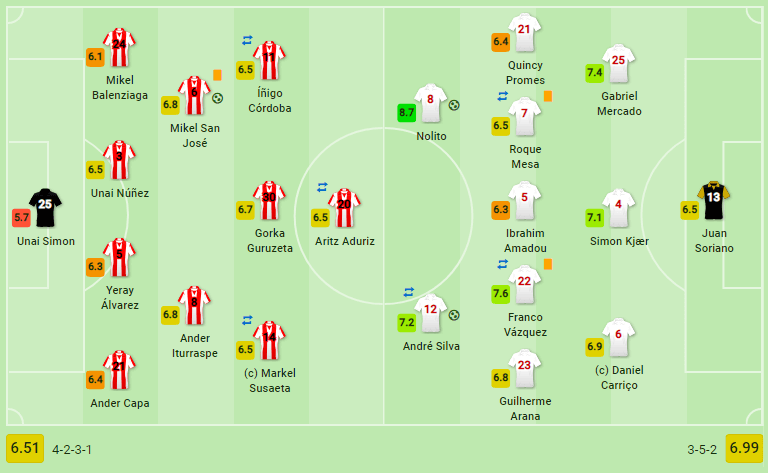
Gaizka Garitano decided to start Mikel San Jose alongside Ander Iturraspe in the middle of the park. In front of them, the trio of Inigo Cordoba, Gorka Guruzeta, and Markel Susaeta supported the lone striker, Aritz Aduriz. Some popular names such as Inaki Willams, Inigo Martinez, and Iker Muniain had to start from the bench.
In the other side, Pablo Machin also opted to bench some of his big-name players, such as Ever Banega, Jesus Navas, and their number-one-goalkeeper, Tomas Vaclik. The gaffer decided to pack his midfield with Roque Mesa, Ibrahim Amadou, and Franco Vazquez. Up front, Milan-loanee Andre Silva started alongside ex-Manchester City player, Nolito.
Silva’s scintillating start
Sevilla started the game with their usual 3–5–2/5–3–2. Early in the game, they would use long balls in their attacks with Andre Silva as their main target. The long passer varied between one of the three CBs or the goalkeeper, Juan Soriano. The Portuguese heating up since the first whistle and his aerial ability gave Athletic’ defence a lot of problems inside the first five minutes.
Bilbao’s promising young defender, Unai Nunez, was his victim. In the fifth minute, Nunez miscalculated a long ball thus giving Andre Silva a clear space to attack. Roque Mesa, who went forward, scored from the situation but his goal was cancelled due to the earlier foul to Unai Simon. Less than a minute later, Nunez made another costly mistake. The away side didn’t let him off this time. Vazquez roamed forward and then slotted the ball into the pathway of Nolito. The latter then scored easily past Simon just six minutes into the game.
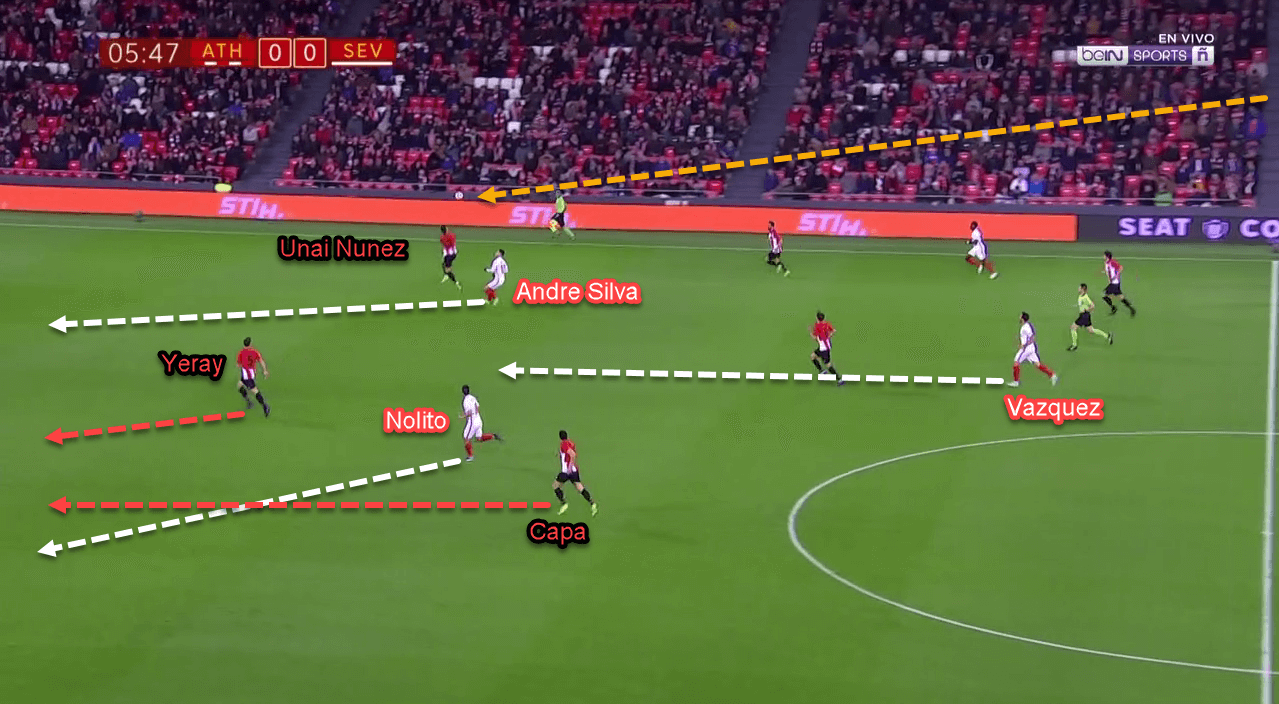
Athletic’ approach
On the ball, Athletic used 4–2–3–1. They sent their full-backs, Ander Capa and Mikel Balenziaga, high early in the game with their double pivots controlling the game from the halfway line. The home side’s attacking midfielders were quite narrow and mainly positioned between the lines in order to give the team a superiority in the dangerous area. Their talisman, Aduriz, usually dropped to combine with the attacking midfield trio.
Early in the game, Bilbao exploited Sevilla‘s 5–3–2 defensive shape quite well. They did this by pushing their full-backs high and wide, with Capa as the more offensive full-back. They would build the game through the left side before sending the ball to Capa. Susaeta’s positioning in the right half-space pinned both Capa and Vazquez with him thus giving Capa a lot of space to roam.
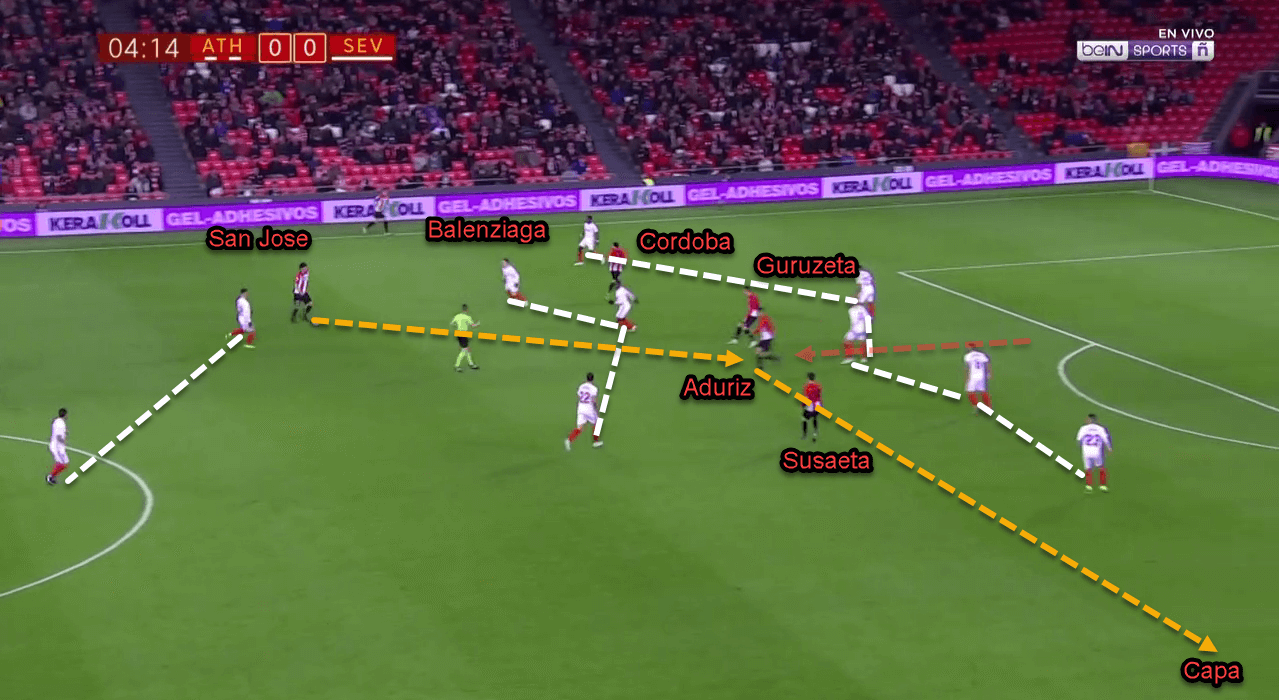
To my surprise, Bilbao didn’t do this often after the first 10 minutes despite the good progress they were having. Instead, they would play safer for most of the remaining 35 minutes of the first half. By safer I mean they didn’t try to find Capa, who already roamed forward, but the midfielder would return the ball into the CB before sending the ball into the right-back. The ball movements were also relatively slower and more predictable. Weird, to say the least.
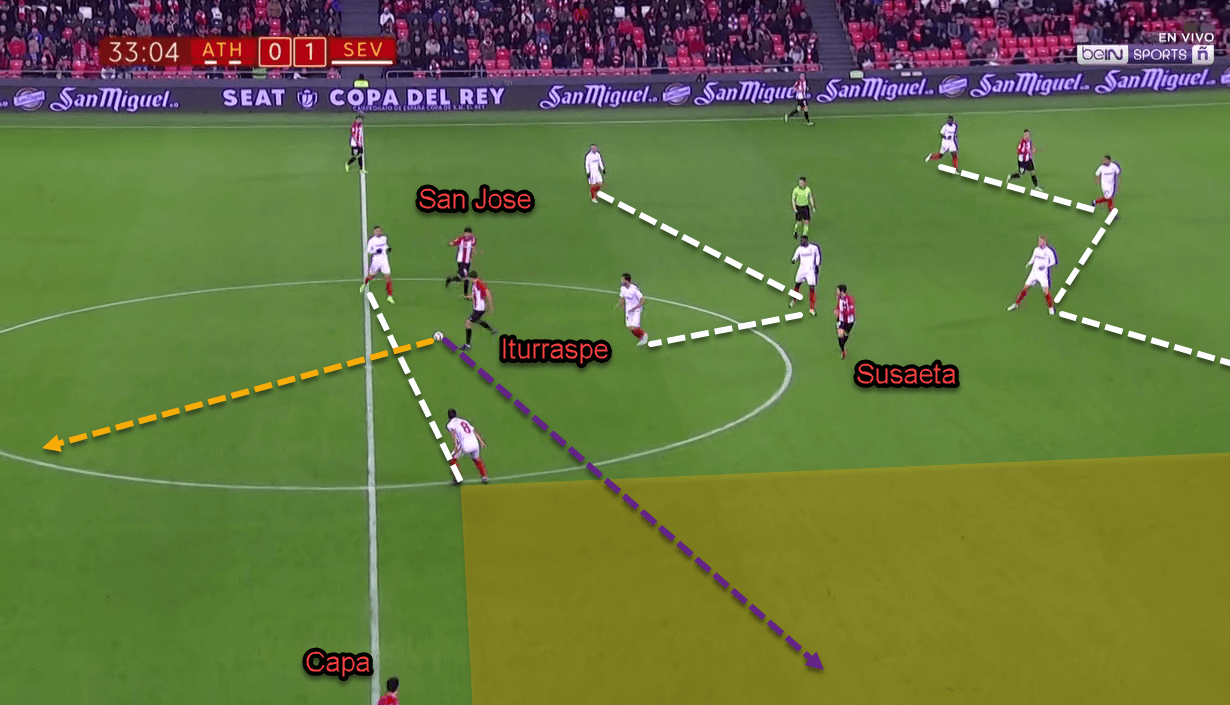
Athletic’s safe-but-confusing approach allowed Sevilla’s midfielders to reorganise. Mesa-Amadou-Vazquez then would arrive comfortably to the side where the ball is being played. The midfield trio then would be able to prevent Capa and Susaeta from creating problems to the defenders behind them. This also forced Bilbao to play in counterproductive U-shaped build-ups.
Because of the visitors’ early lead and their tendency to sit back, Athletic got the lion’s share of possession in the first half. Bilbao rarely had to defend for more than 30 seconds due to that fact. When they did lose the possession, they would shape themselves in 4–4–1–1.
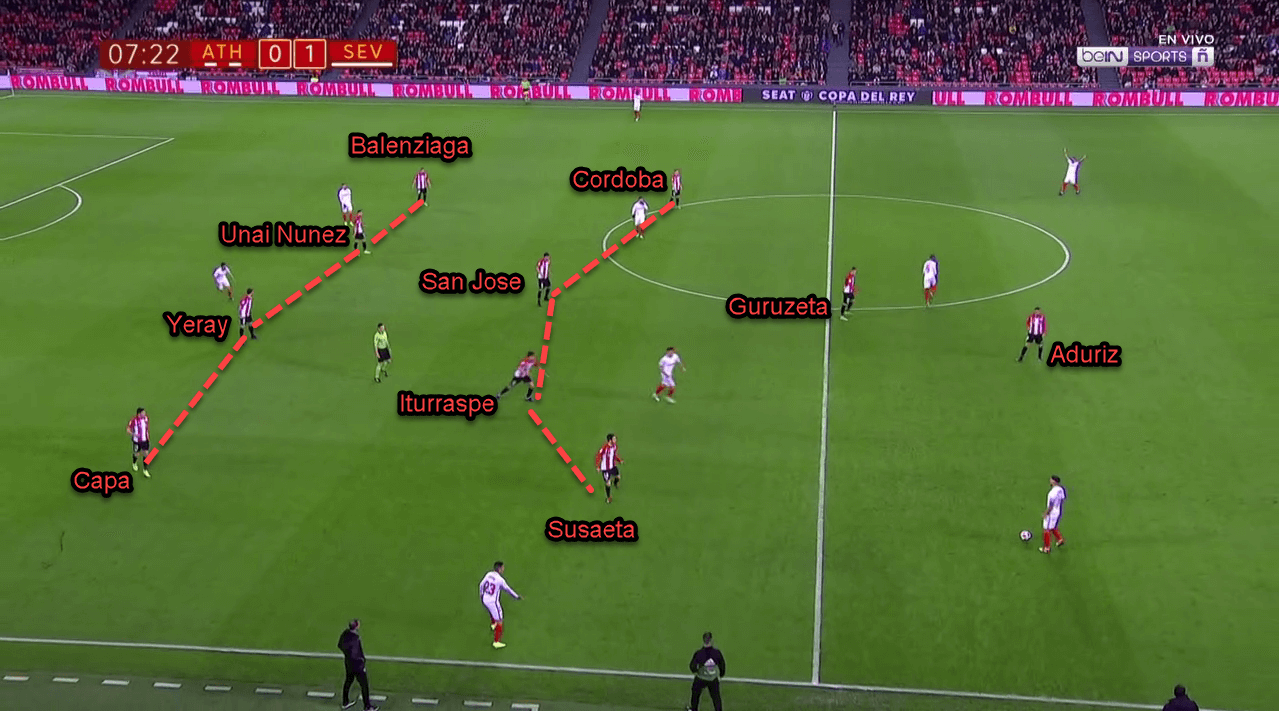
Remember Andre Silva and his supreme ability to deal with long balls? Let’s get back to that. Apart from long balls sent by Gabriel Mercado, Simon Kjaer, or Daniel Carrico, Sevilla also had another option. This time by using goal-kicks from their goalkeeper, Soriano. Soriano’s goal-kicks were usually accurate to find Andre Silva high up the pitch.
Garitano, who didn’t want the opposing striker to dismantle his defensive department anymore, tasked Iturraspe to drop into the last line; thus creating a temporary 5–1–3–1. This approach succeeded to reduce Andre Silva’s aerial threat because the striker had to face at least two towering men in order to win the ball.
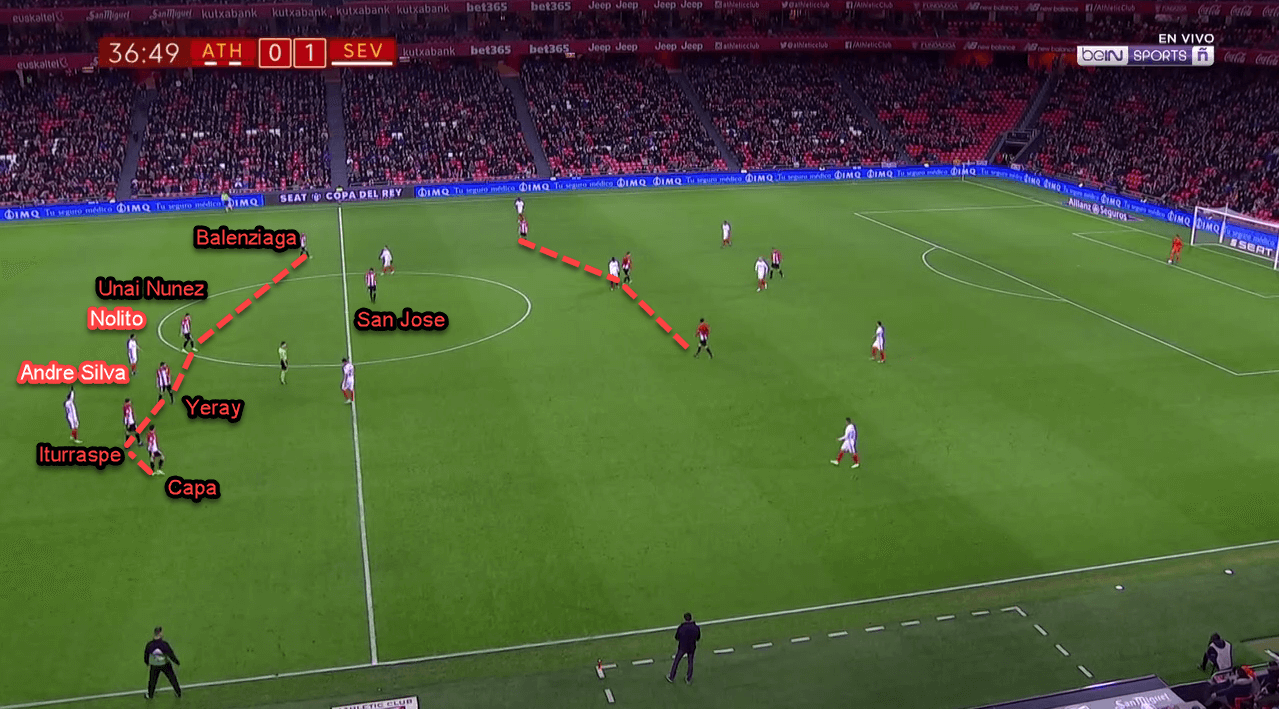
Athletic varied their approach by sending a lot of (early) crosses into the box. They hoped their gunman, Aduriz, could convert the crosses into dangerous chances. Most of them failed, due to Sevilla’s disciplined CB trio preventing the ball arriving at Aduriz’s head.
He did score, by the way, but his goal was cancelled by a VAR decision due to his offside position earlier in the build-up of the goal. To add more misfortune for the home side, Aduriz was forced to be taken off before the first half finished. This happened because of a knee injury midway the first half.
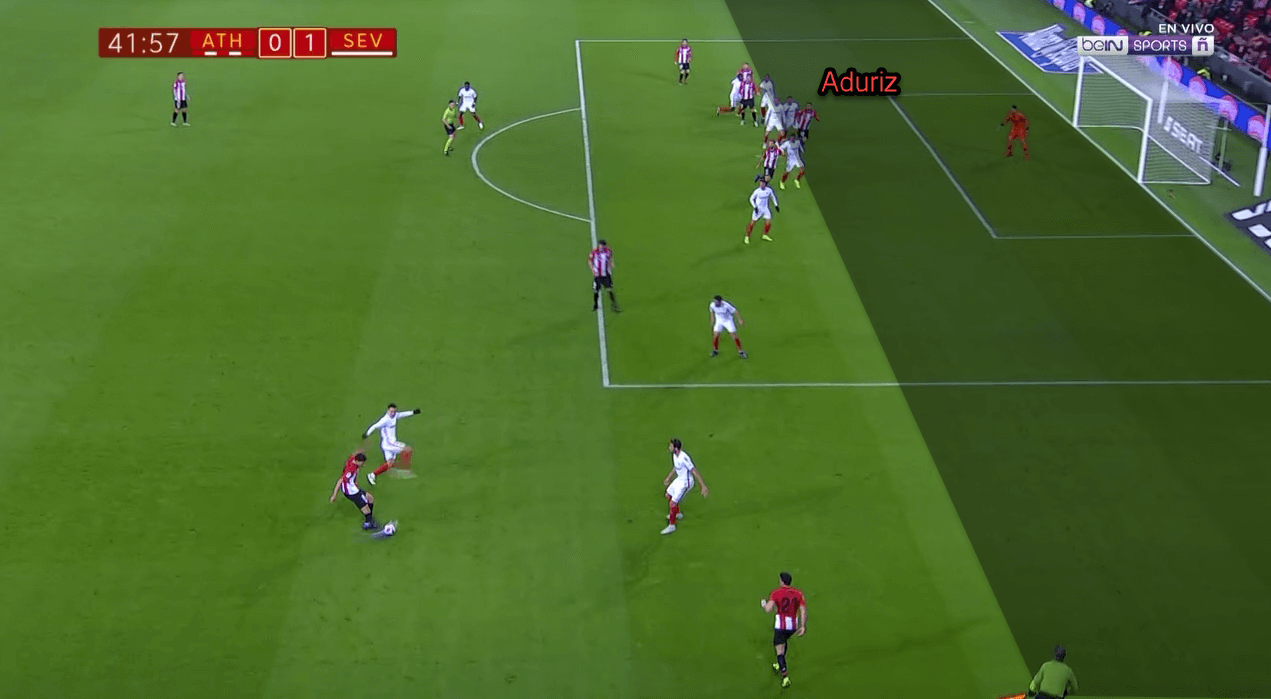
Machin’s machine
As we can see before, Sevilla played with 5–3–2 defensively. With that shape, they allowed Bilbao huge spaces next to their midfield trio. Lucky for them, the home side didn’t exploit this for most of the first half.
Machin also tasked his men to play very compact vertically by reducing the distance between each line. This meant Bilbao’s players had less time and space on the ball, thus forcing them to make errors in possession. The away side’s defensive department was also very sound and discipline. Despite playing a relatively high line for some moments in the first half, they allowed zero successful through passes behind them.
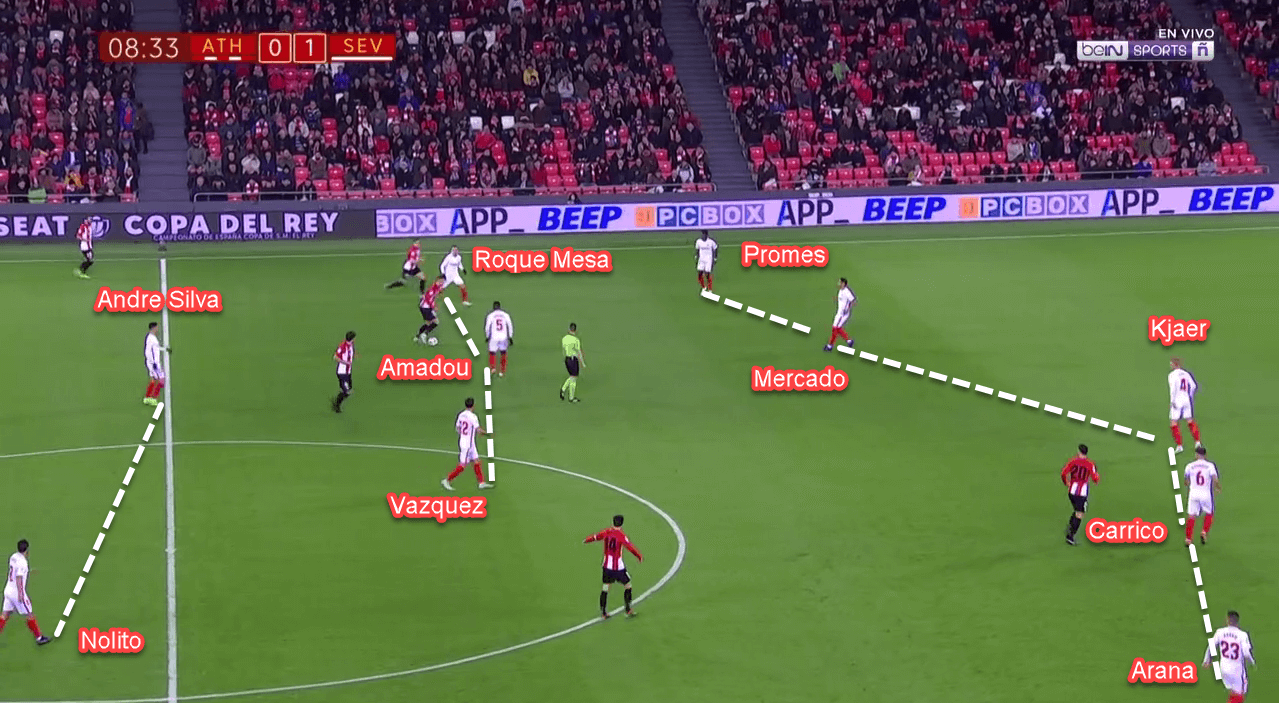
On the ball, Sevilla opted to play in 3–1–4–2. The absence of Banega in the first half can be felt because of Amadou’s lack of game-controlling ability. When they got the ball in the midfield, Roque Mesa and Vazquez were tasked to bring the ball forward; either by distributing the ball to the flanks or carrying the ball by themselves. When the ball reached the final third, Sevilla’s wing-backs (mainly Quincy Promes) would try to find one of the strikers with his crosses.
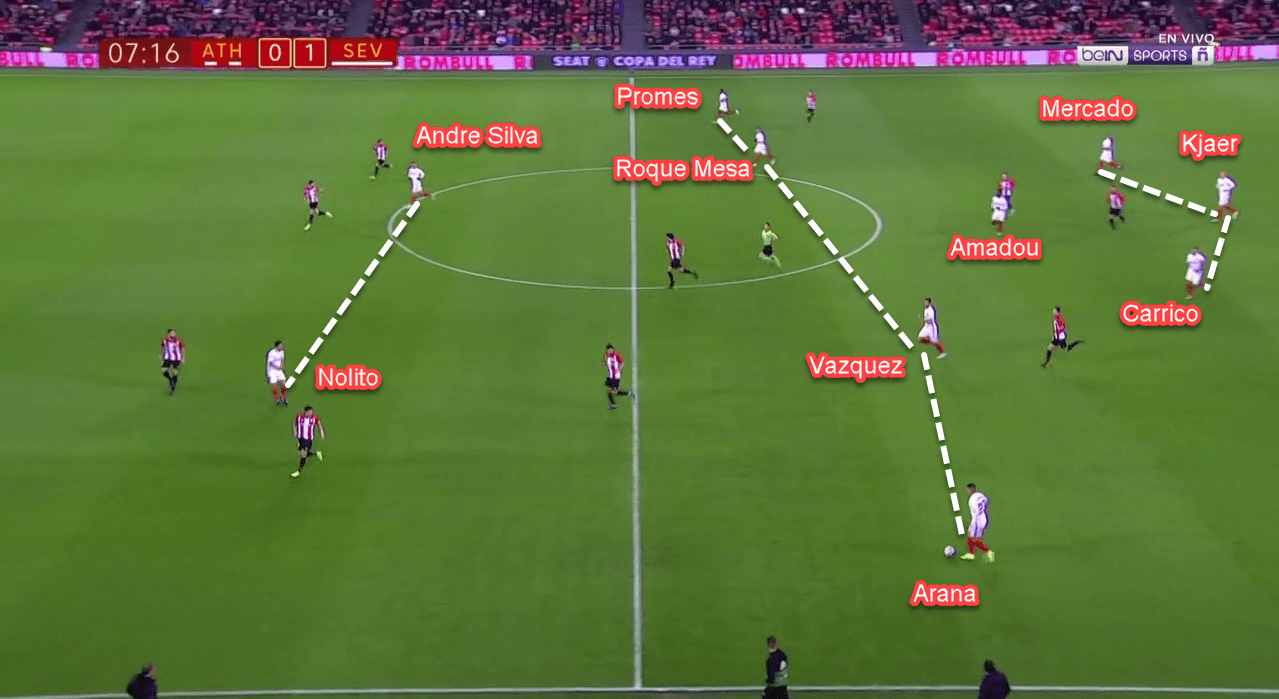
Alterations equal improvements, right?
To some extent, yes. That happened to Athletic. The home side switched into a back-three early in the second half, with Iturraspe dropping between Yeray Alvarez and Nunez in order to help his team’s build-up process. Athletic then moved into a 3–4–3-ish shape with Muniain dropping next to San Jose, filling Iturraspe’s vacated position. Susaeta and Cordoba remained narrow; thus allowing Capa and Balenziaga to fill the flanks.
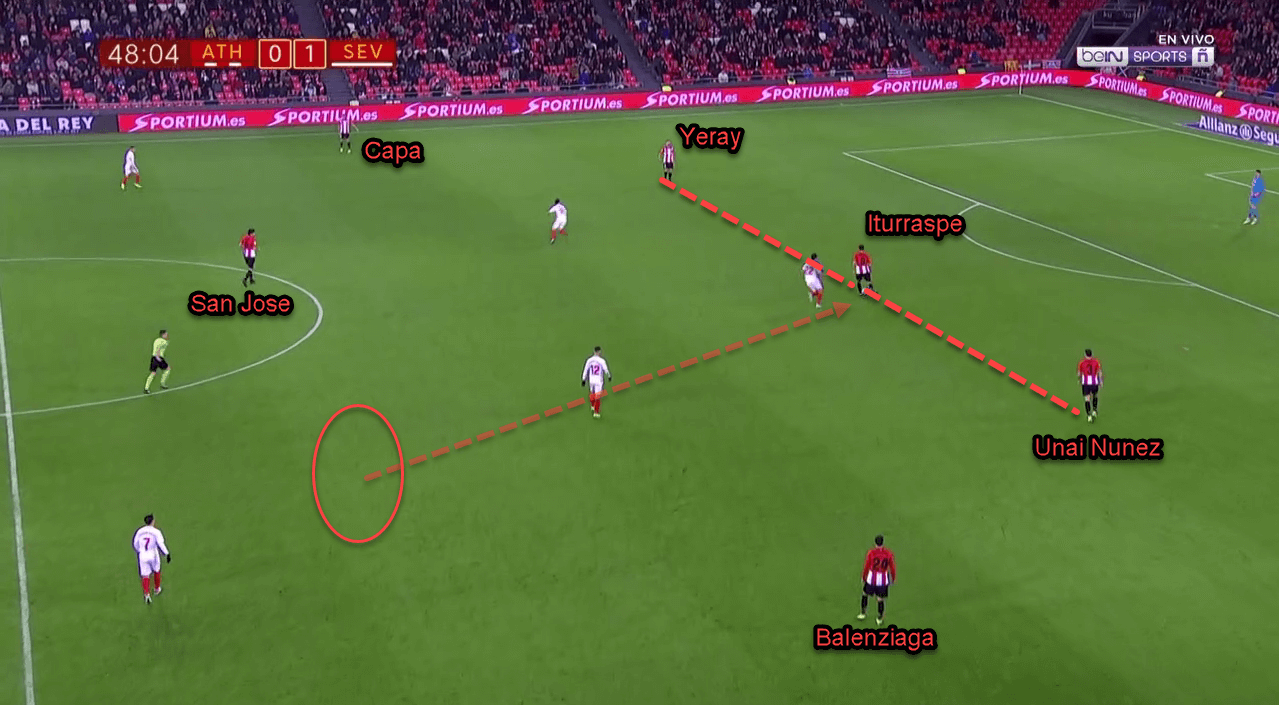
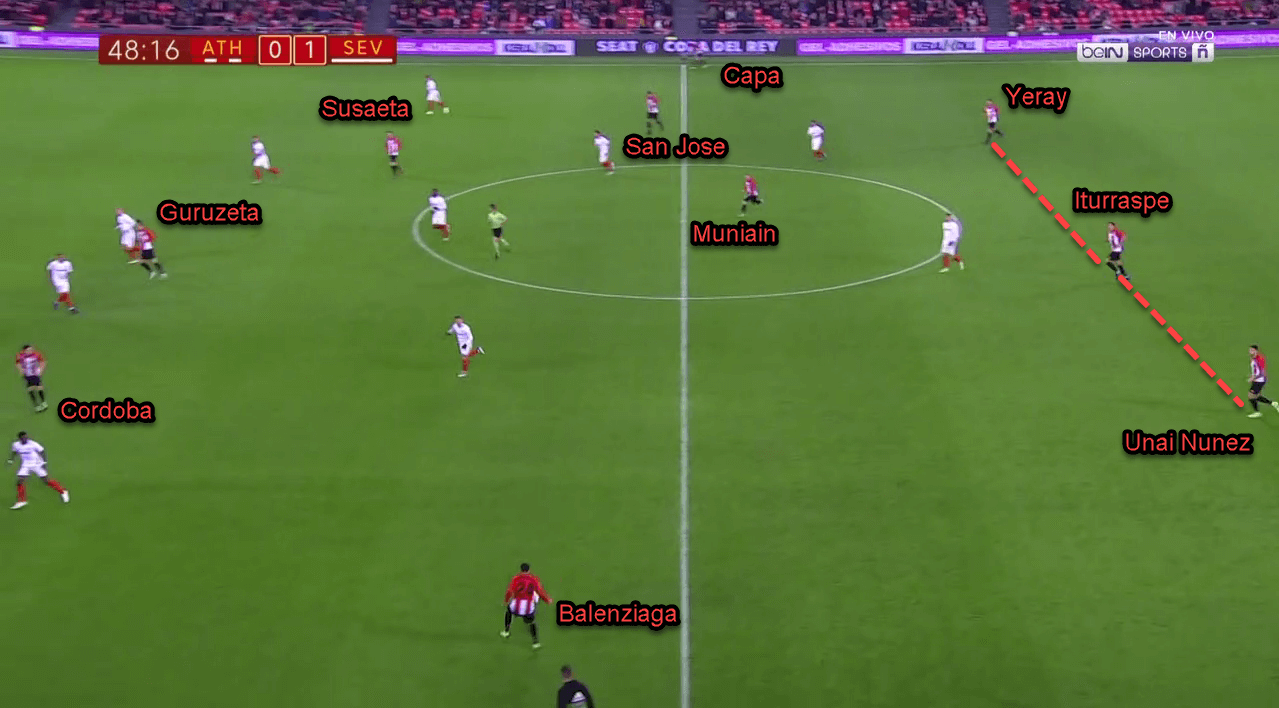
Less than a minute after Iturraspe dropped between the CB pair, Bilbao got a corner in their left-hand side. Susaeta was tasked to take the corner and he did it brilliantly. His superb cross combined with San Jose’s towering header resulted in a long-awaited goal for the home side. 1–1. Garitano’s genius alterations proved effective so far.
Not so quick, Gaizka…
Machin reacted to his rival’s alterations by making some adjustments to his squad. Nolito, who stood alongside Andre Silva in the first half, was tasked to drop a bit to play behind the striker. Sevilla’s shape in attack changed a bit into a 3–5–1–1.
The goalscorer then went crazy in his new position. He successfully destroyed Athletic’s defence by exploiting the huge gap between the lines. Four minutes after San Jose’s goal, Nolito received a ball between the lines without any pressure whatsoever. Then he played a perfectly-weighted through pass for Andre Silva, who scored with his first touch. Garitano’s tactical changes went into thin air, credit to Nolito’s magic.
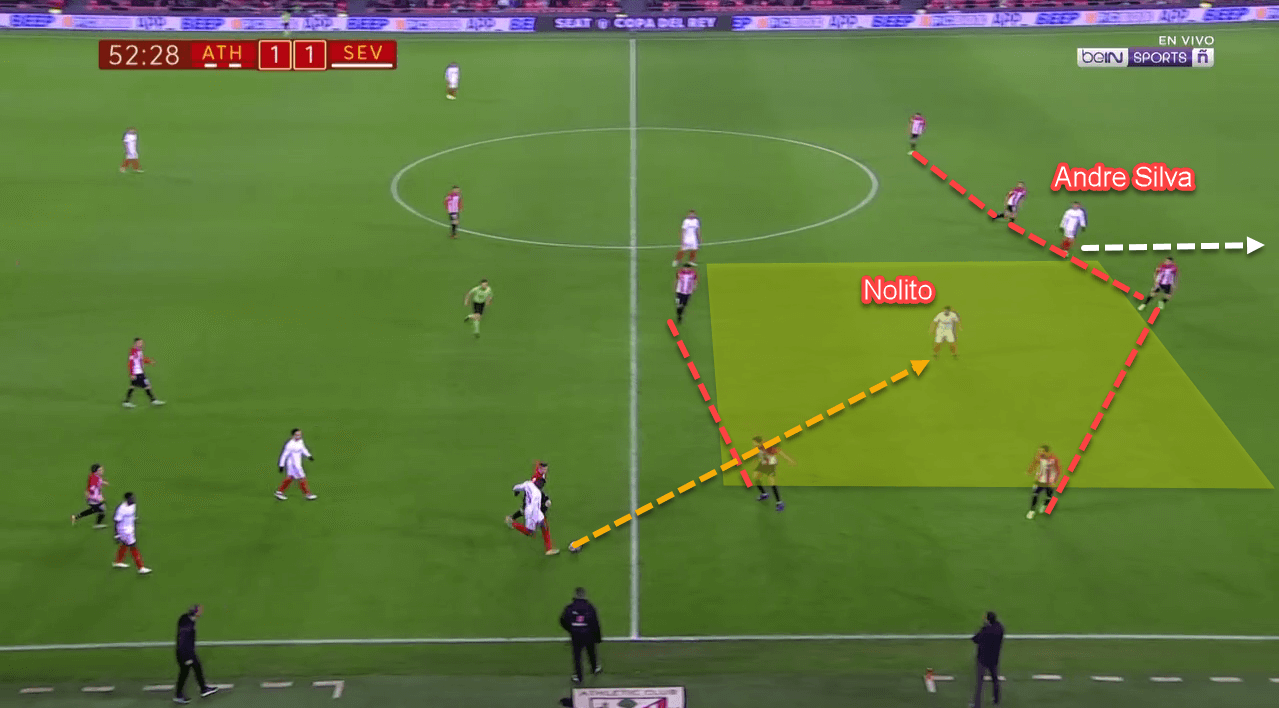
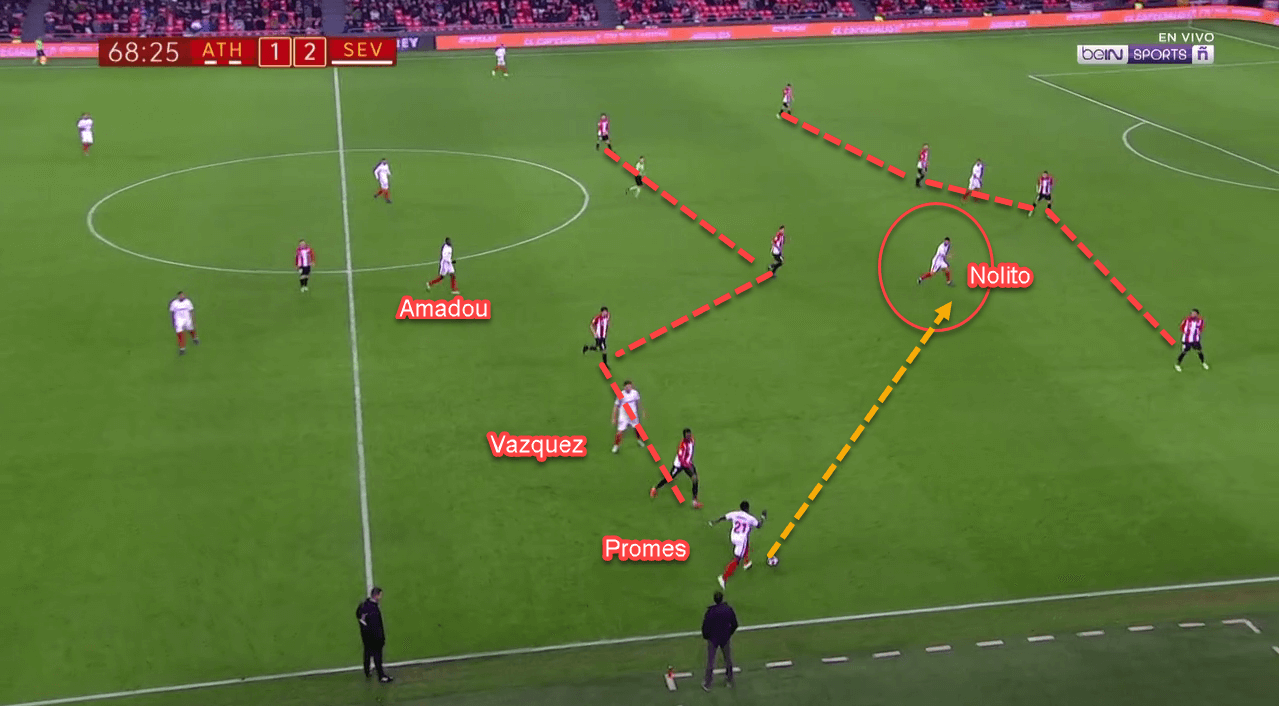
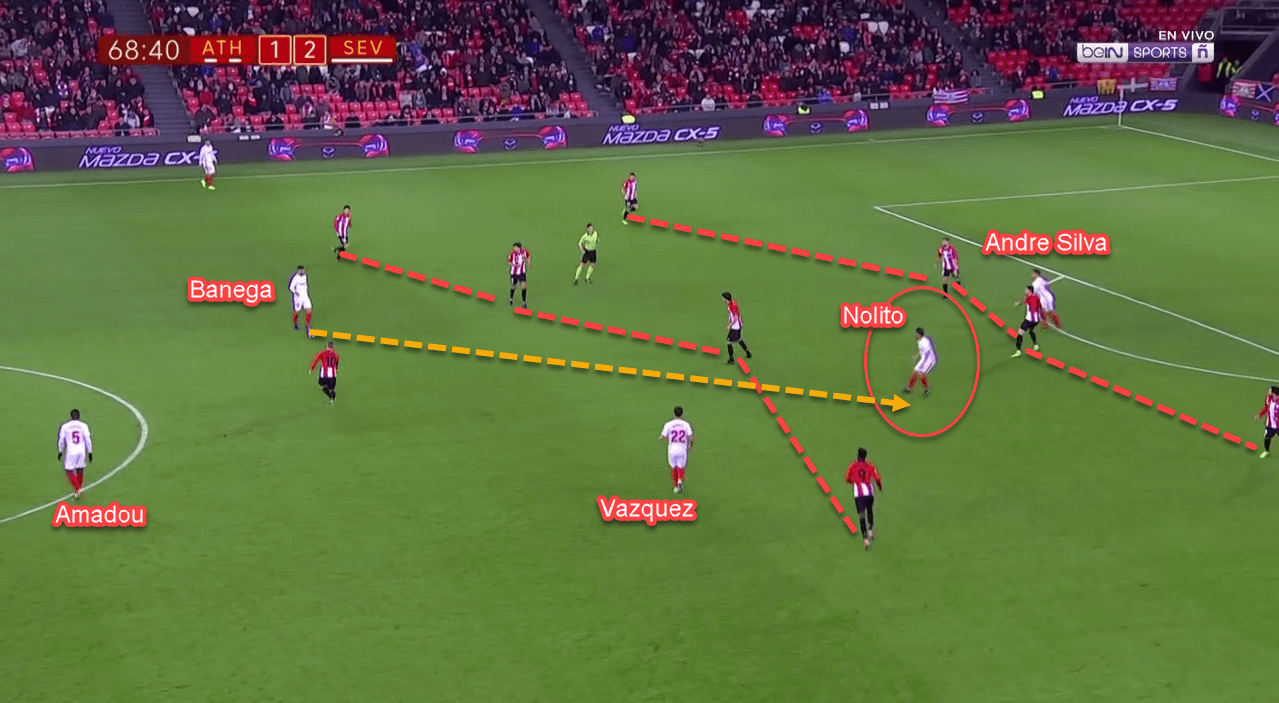
Not only in attack, but Nolito also had a new role off the ball. From the start of the second half until the 60th minute, Machin tasked Nolito to drop back and fill the midfield in order to create 5–4–1. The 5–4–1 shape was introduced by Machin in order to reduce Capa’s offensive threats and to give Sevilla more solidity in midfield.
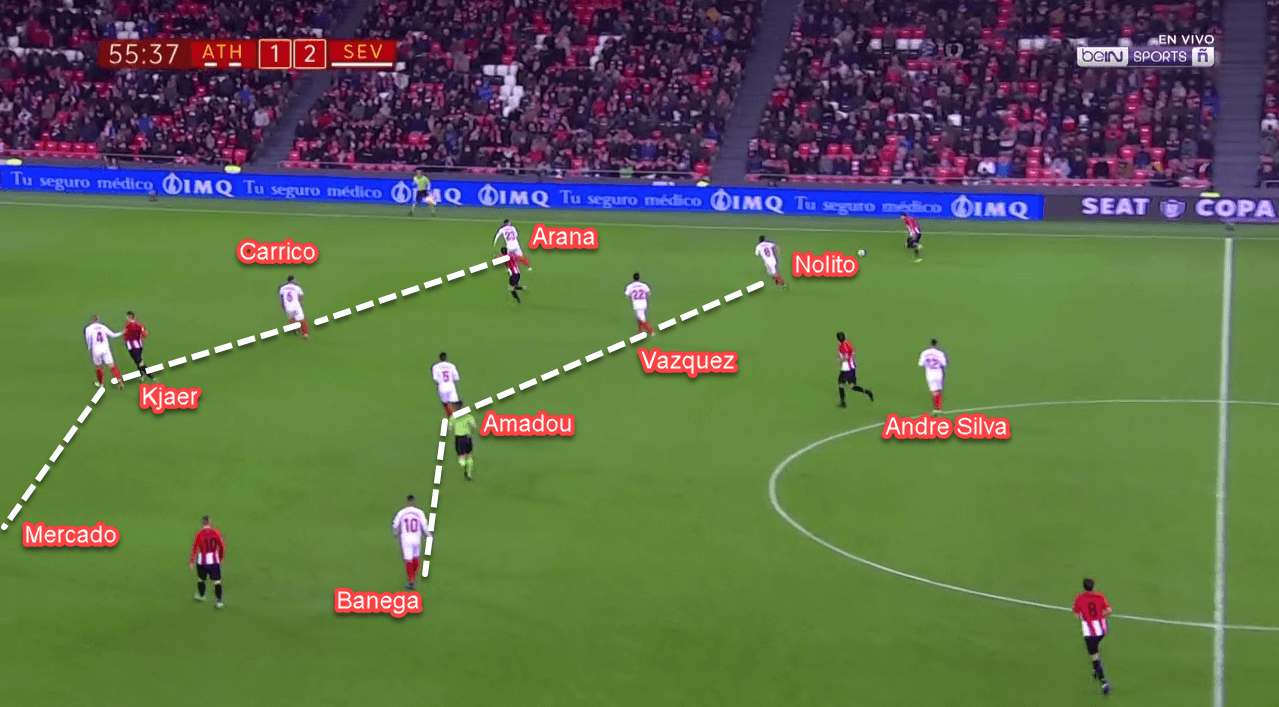
Another Athletic adjustment
Different from his previous placement behind the striker in the first half, Muniain was given more responsibility in the second half. He got a full license to roam in the left half-space. In the 3–4–3-ish formation, Muniain dropped next to San Jose to collect the ball and make plays for his team. When his team moved into their initial 4–2–3–1, he went higher in order to create more the final third. This gave Bilbao problems because Muniain had supreme on-ball abilities.
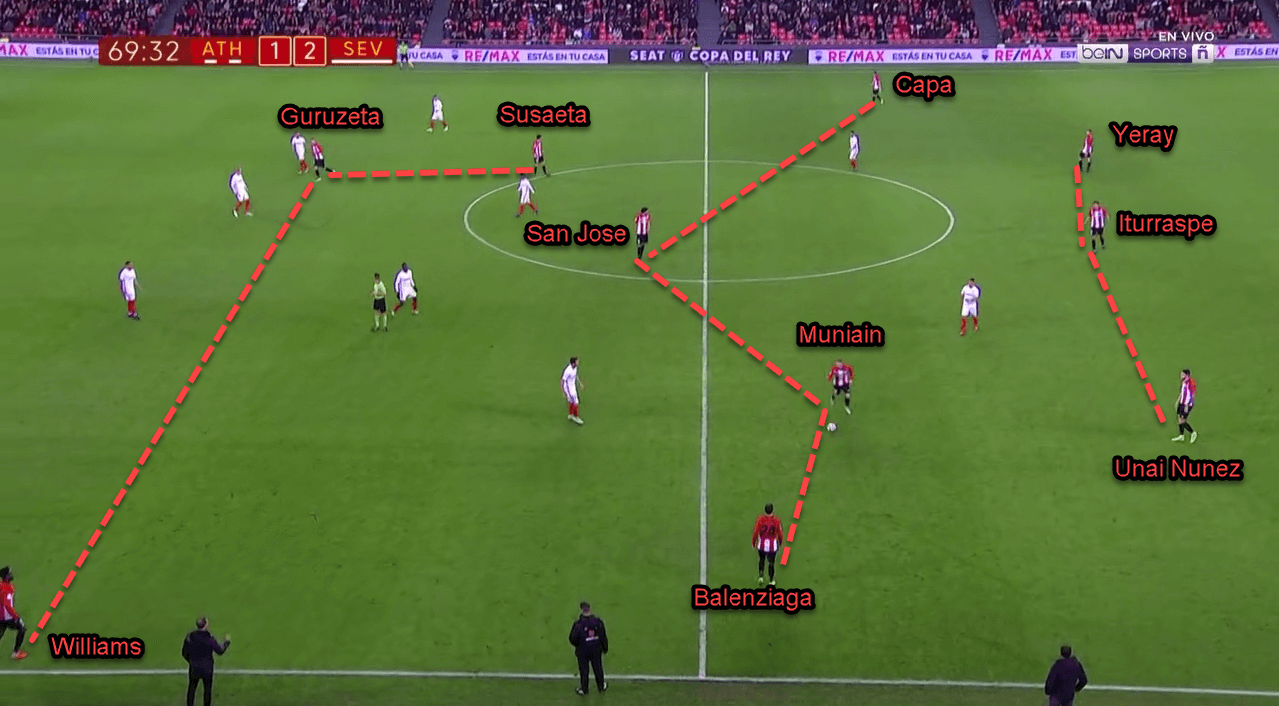
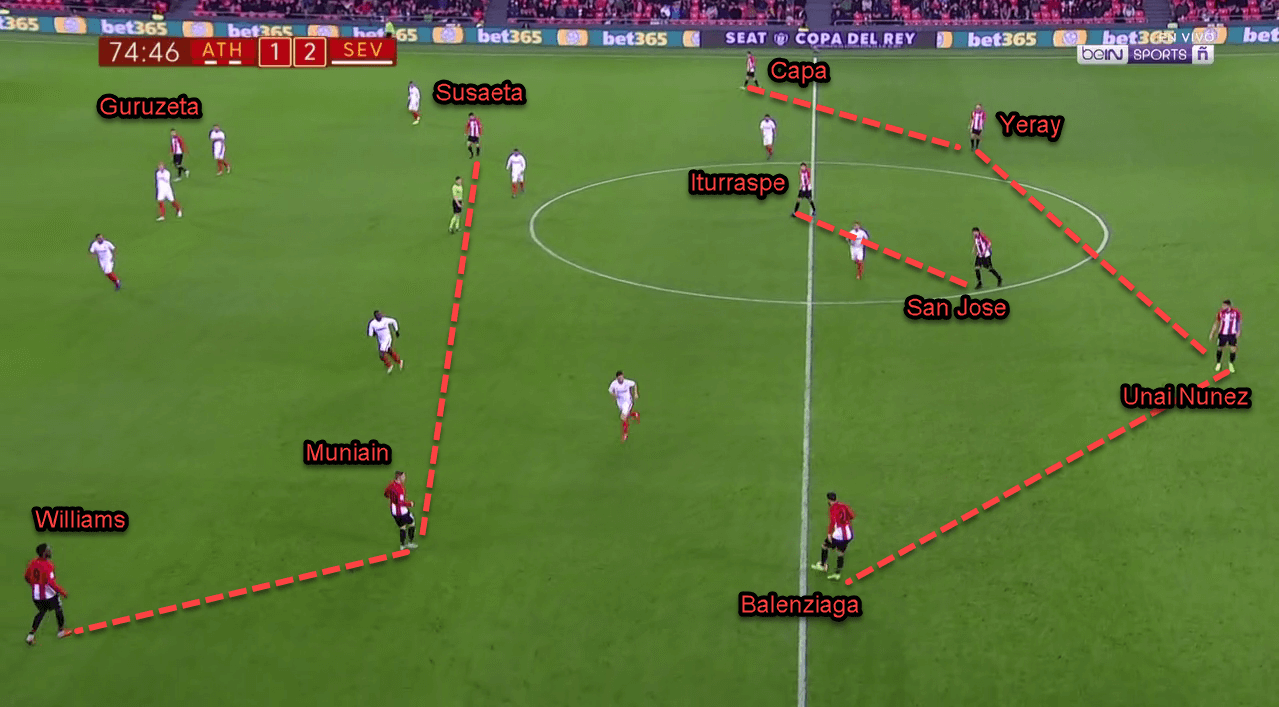
Bilbao’s attacking issues
After the 60th minute, Sevilla returned to their starting shape, 5–3–2; Bilbao were still unable to exploit this. What happened?
First of all, Garitano didn’t choose to make overloads in the flank, instead, he allowed his men to occupy the central lanes. That was counterproductive since Sevilla would always have more men in the central area. His team were also very slow in distributing the ball and often neglecting an option to switch; which actually could disorganise the opponent’s defence. Even the introduction of Williams added almost zero effect.
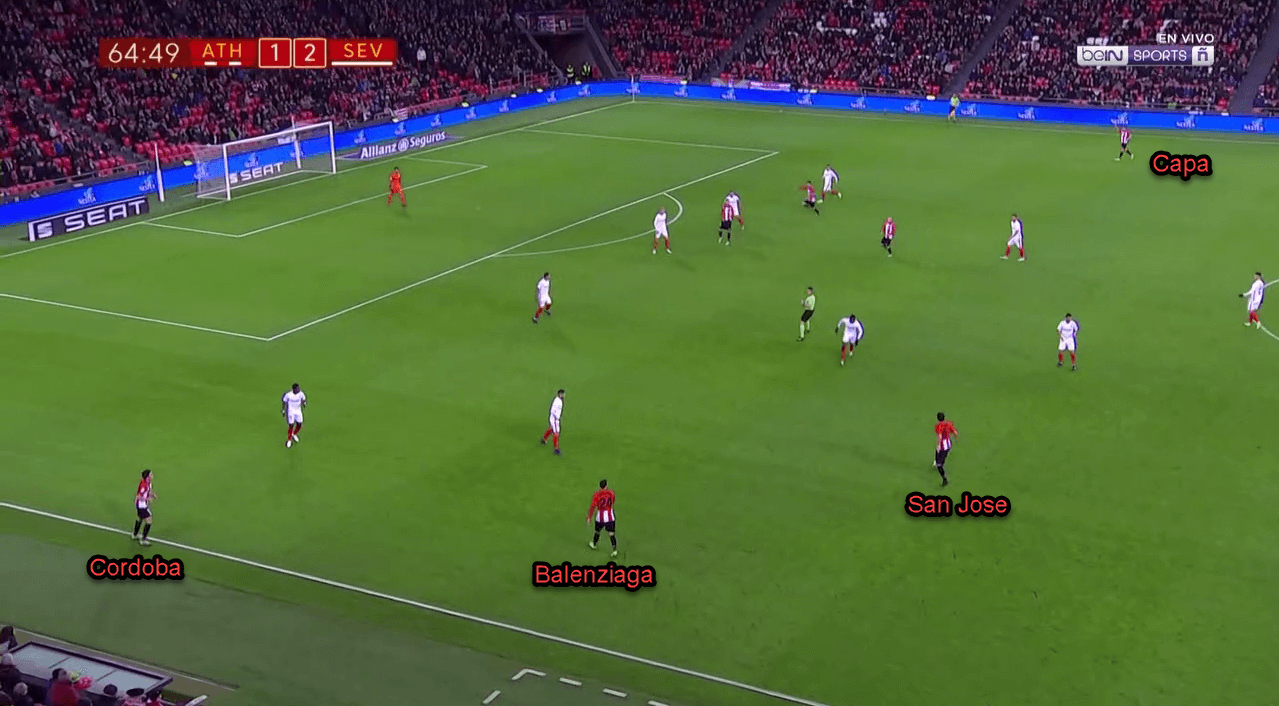
Well, Bilbao did try to overload the left-hand side once; with Muniain, Williams, and Balenziaga combining. Sevilla reacted well to this, by sending, Mercado, and Amadou to prevent the ball being played into Muniain. In this case, San Jose should move forward in order to fill the space left by Amadou. If San Jose moved forward, Amadou (and Mercado) would probably stay in their position thus enabled Muniain to receive more comfortably.
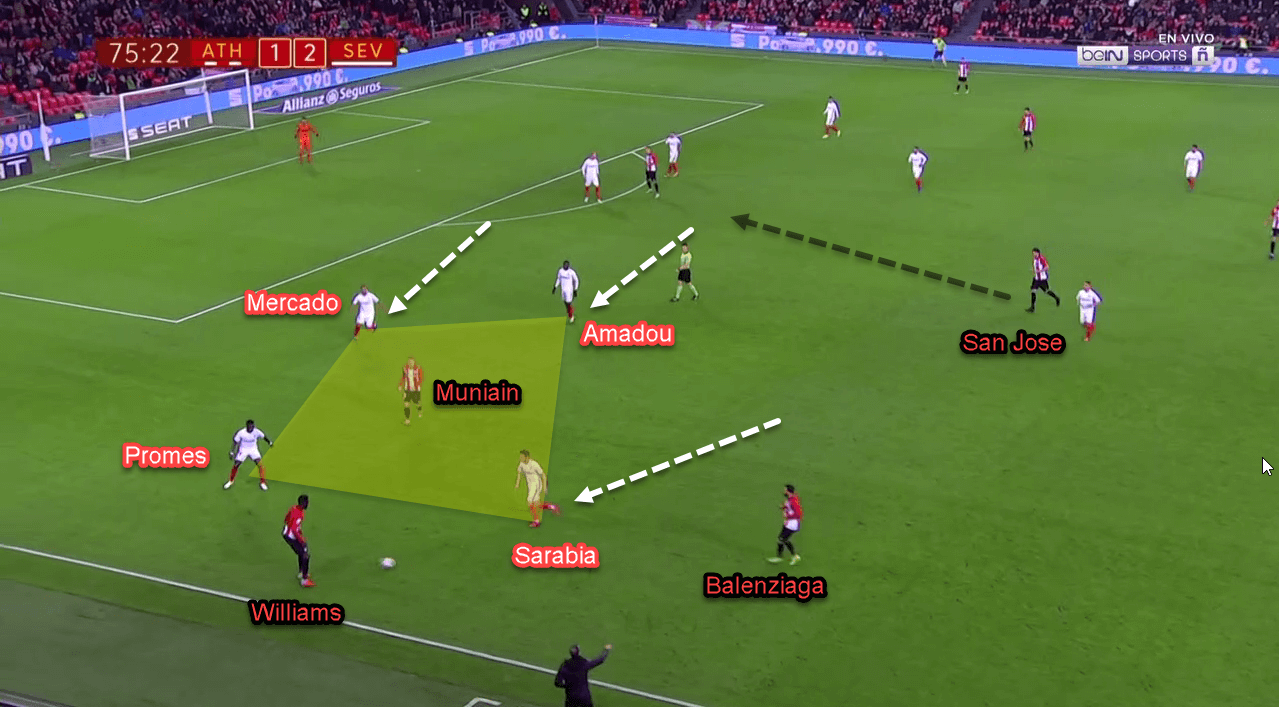
Conclusion
What a night for Nolito. He played in three positions throughout the night (left striker, left midfielder, attacking midfielder), scored the opening goal, and assisted the other two. His brilliance came into light especially in the second half, by playing behind the main striker. In that position, he created chaos to the home side’s defence. Definitely unplayable.
But Nolito has to give credit where it’s due. Pablo Machin showed his tactical superiority in every aspect of this game by successfully adjusting to the demands of the game. In the other side, Gaizka Garitano’s side looked clueless at times. Garitano now has a huge responsibility to bring the confidence back into his team in this already-hard season.
Onto the next one.
If you love tactical analysis, then you’ll love the digital magazines from totalfootballanalysis.com – a guaranteed 100+ pages of pure tactical analysis covering topics from the Premier League, Serie A, La Liga, Bundesliga and many, many more. Get your copy of the FIRST of two December issues for just ₤4.99 here, or the SECOND of the December issues with an annual membership right here.

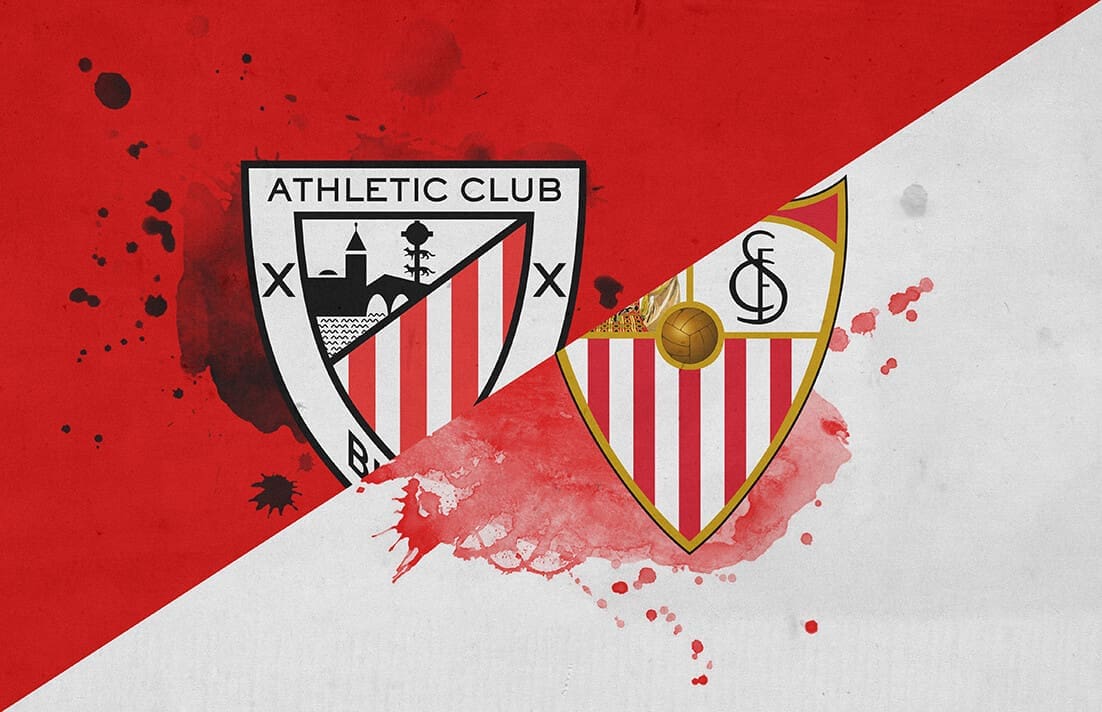
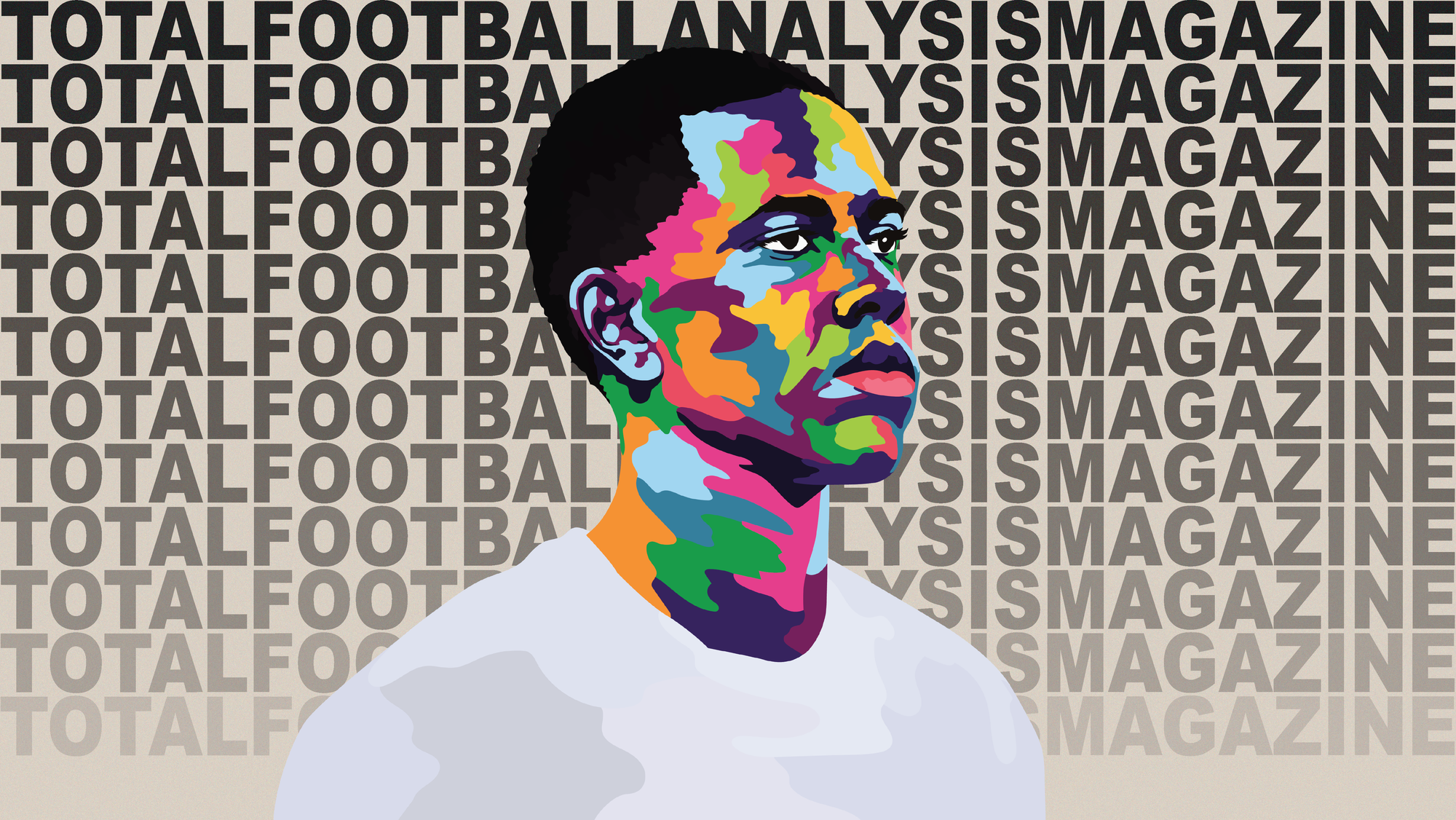
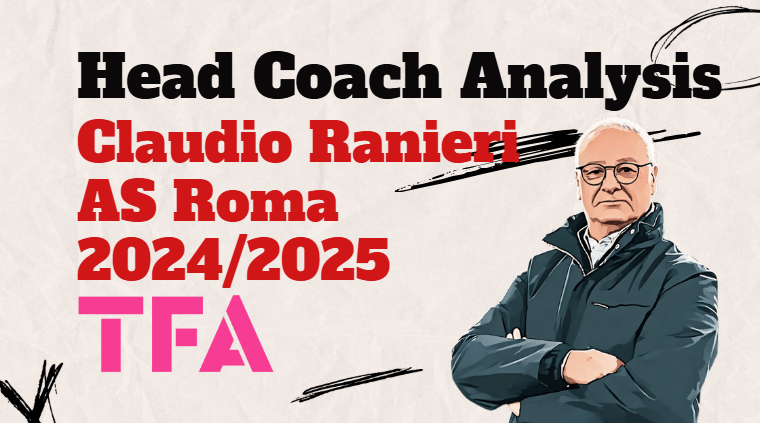

Comments